
About UsThe Numismatic Bibliomania Society is a non-profit organization promoting numismatic literature. For more information please see our web site at coinbooks.org SubscriptionsThose wishing to become new E-Sylum subscribers (or wishing to Unsubscribe) can go to the following web page link MembershipThere is a membership application available on the web site Membership Application To join, print the application and return it with your check to the address printed on the application. Membership is only $15 to addresses in the U.S., $20 for First Class mail, and $25 elsewhere. For those without web access, write to: David M. Sundman, Secretary/TreasurerNumismatic Bibliomania
Society AsylumFor Asylum mailing address changes and other membership questions, contact David at this email address: dsundman@LittletonCoin.com SubmissionsTo submit items for publication in The E-Sylum, just Reply to this message, or write to the Editor at this address: whomren@coinlibrary.com
BUY THE BOOK BEFORE THE COINYou won't regret it! |
- WAYNE'S WORDS: THE E-SYLUM MARCH 1, 2009
- UPDATE: 100 GREATEST WORKS OF AMERICAN NUMISMATIC LITERATURE
- LAKE BOOKS 97TH NUMISMATIC LITERATURE MAIL BID SALE
- FANNING NUMISMATIC LITERATURE OPENS ON FACEBOOK
- NEW BOOK: NEW MEXICO TRADE TOKENS II
- APRIL 2009 COLONIAL NEWSLETTER PUBLISHED
- WORLDWIDE COINS: THE ESSENTIAL BOOKSHELF
- MCA ORAL HISTORY INTERVIEW OF ERIC P. NEWMAN
- TRADE TOKENS BOOK AUTHOR AL ERICKSON
- THE TOKENS OF MAGICIAN HERR ALEXANDER
- A SPANISH CIVIL WAR BANKNOTE BOOK
- MORE ON THE SCOPE OF NUMISMATIC BOOKS
- MORE ON THAT COIN TONING EFFECT: NEGATIVE SHADOW AND SURFACE DISPLACEMENT
- QUERY: TERMITE FUMIGATION EFFECTS ON BOOKS
- WORLD COINS SOUGHT FOR PHOTOGRAPHY BOOK
- U.S. COIN BOOKS, CHINESE PRINTERS, AND CHINESE COIN FAKES
- MORE ON THE LAW AND NUMISMATIC BOOK TRANSLATION
- HAPPY BIRTHDAY TO THE CHICAGO COIN CLUB
- 2009 PORTLAND NATIONAL MONEY SHOW MEDALS OFFERED
- LAWRENCE MEYERS ON STANFORD INTERNATIONAL'S NUMISMATIC INVESTMENTS
- MORE ON THE DEBATE FOR AND AGAINST NUMISMATIC MUSEUMS
- FEATURED WEB PAGE: COUNTERFEITS & FORGERIES
WAYNE'S WORDS: THE E-SYLUM MARCH 1, 2009
 Among our recent subscribers are Billy Kiser, courtesy of Alan Weinberg, and Alberto Paashaus. Welcome aboard! We now have 1,221 subscribers.
Among our recent subscribers are Billy Kiser, courtesy of Alan Weinberg, and Alberto Paashaus. Welcome aboard! We now have 1,221 subscribers. This week we open with an update on the NBS survey of the 100 Greatest Works of Numismatic Literature, followed by news from literature dealers Fred Lake and David Fanning.
Next up are a review of a new book on New Mexico trade tokens by Alan Weinberg, notes on the latest Colonial Newsletter, Dick Johnson's commentary on The Collector's Essential Bookshelf, and a marvelous interview with numismatist Eric P. Newman.
In topics carried over from previous issues we have some great items on the tokens of Herr Alexander and that coin toning effect (for which we've now identified a name). Other topics include Chinese printers of numismatic books, and the law and numismatic translation.
To learn about negative shadow and surface displacement, read on. Have a great week, everyone!
Wayne Homren
Numismatic Bibliomania Society
UPDATE: 100 GREATEST WORKS OF AMERICAN NUMISMATIC LITERATURE
Len Augsburger writes:LAKE BOOKS 97TH NUMISMATIC LITERATURE MAIL BID SALE
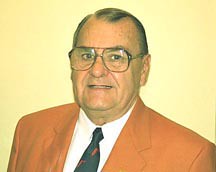 The 97th mail-bid sale of numismatic literature is now available for viewing on our web site at www.lakebooks.com/current.html . The sale features selections from the library of John T. Hamilton III, Part Two (and other consignors). Bids may be placed via email, telephone, fax or regular mail until the closing on Tuesday, March 24, 2009 at 5:00 PM (EDT).
The 97th mail-bid sale of numismatic literature is now available for viewing on our web site at www.lakebooks.com/current.html . The sale features selections from the library of John T. Hamilton III, Part Two (and other consignors). Bids may be placed via email, telephone, fax or regular mail until the closing on Tuesday, March 24, 2009 at 5:00 PM (EDT).FANNING NUMISMATIC LITERATURE OPENS ON FACEBOOK
David Fanning writes: I've set up a Facebook page for David F. Fanning Numismatic Literature. I've been using Facebook for a bit, and as it grows in popularity, I've been contacted by a few customers and fellow bibliophiles who wanted to link to my personal page. As I use the personal page to stay in touch with old college friends, post photos of my son, and other non-business matters, I thought it best to create a separate page for my business.
I've set up a Facebook page for David F. Fanning Numismatic Literature. I've been using Facebook for a bit, and as it grows in popularity, I've been contacted by a few customers and fellow bibliophiles who wanted to link to my personal page. As I use the personal page to stay in touch with old college friends, post photos of my son, and other non-business matters, I thought it best to create a separate page for my business.Facebook being what it is, it will largely be up to readers to determine exactly what form this page takes. I intend to use the page as a sort of supplementary Web site (in addition to my real one at www.fanningbooks.com), and use it for things like photo albums and other fun, less immediately commercial postings. I don't believe I can post catalogues and such on it, so if you feel the need to buy something from me, you'll have to go to the fanningbooks.com site, which remains the primary Web site for the business. I'll be curious to see what people think. To find the page, just go to facebook.com and search for David F. Fanning Numismatic Literature.
NEW BOOK: NEW MEXICO TRADE TOKENS II
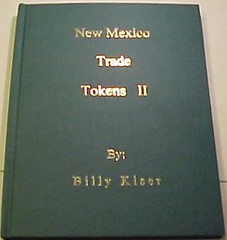 There haven't been many recently published exonumia or token books mentioned in The E-Sylum, but this week I received one that I've eagerly anticipated.
There haven't been many recently published exonumia or token books mentioned in The E-Sylum, but this week I received one that I've eagerly anticipated.Author Billy Kiser, all of 22 and a college student now, has just released a color plate, hard cover 222-page book titled New Mexico Trade Tokens [part] II. Kiser, at the age of 17 yrs had already distinguished himself as author of a previous black & white plated New Mexico token book with values, rarities and a well-respected knowledge of old New Mexico trade tokens - which is where he and his dad Dan (also a serious token collector) live.
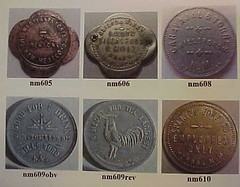 This significant expansion of the first book, with its large 8 x 11 hardcover format, many hundreds of color plates of rare tokens, thousands of listings with rarities and current (conservative) values really outdoes the original book. The color plates are a feature unknown to me in any other token reference. The book has a good quality hardcover binding and paper too.
This significant expansion of the first book, with its large 8 x 11 hardcover format, many hundreds of color plates of rare tokens, thousands of listings with rarities and current (conservative) values really outdoes the original book. The color plates are a feature unknown to me in any other token reference. The book has a good quality hardcover binding and paper too.New Mexico is perhaps the most difficult state to get Old West tokens from, so this book really fills a niche. I recommend it highly, not to just token collectors but enthusiasts of the Old West.
Only 400 copies were printed, half the printing a B&W plate edition at $50 postpaid (media mail) and half a color plate version at $65 ppd. Guess which one will sell out first? The author can be reached at bkiser86@yahoo.com or PO Box 196 Fairacres, NM 88033
Who says there's no "young blood" in the hobby? Like John Kraljevich before him, Billy Kiser has impressed those that know him as a future Q. David Bowers.
APRIL 2009 COLONIAL NEWSLETTER PUBLISHED
 The April 2009 issue of The Colonial Newsletter: A Research Journal in Early American Numismatics (CNL) has been published. As a reminder, the subscription price for 2009 has been significantly reduced. The rates are: $25 per year for ANS members and $40 per year for non-ANS members. Take advantage of this price reduction and contact the ANS to subscribe.
The April 2009 issue of The Colonial Newsletter: A Research Journal in Early American Numismatics (CNL) has been published. As a reminder, the subscription price for 2009 has been significantly reduced. The rates are: $25 per year for ANS members and $40 per year for non-ANS members. Take advantage of this price reduction and contact the ANS to subscribe.This issue starts with two Letters to the Editor with regard to previously published material. Robert Bowser responds to Byron Weston's Letter to the Editor, in CNL-136, concerning late eighteenth-century muled halfpence. Robert suggests yet another plausible theory that explains why there are so many halfpence struck from unrelated dies.
We also received a congratulatory note from the dean of early American numismatics, Eric P. Newman, in reference to Lou Jordan's paper on colonial currency annotations that appeared in our last issue.
Next we present not one, not two, but three Technical Notes. The first two are updates to previously published Technical Notes while the final one is new. First, Dr. Roger Moore reports the discovery of a second specimen of the extremely rare 42½-c New Jersey copper variety. Clem Schettino follows with information on four more New Jersey What'sIt? coppers. Finally, Dr. Steven J. Shephard provides an account of an archaeological find in Alexandria, VA, concerning a 1797 Washington medal.
Wrapping up this issue is a comprehensive paper by Dr. Philip Mossman where he unravels the complex world of the French gold coinages during the seventeenth and eighteenth centuries. It can be a confusing subject but Phil does a superior job of explaining and analyzing each gold coinage issued during the reigns of French kings Louis XIII through Louis XVI.
These coinages had a wide circulation including the British North American colonies. Since our forefathers had to deal with the intricacies of these coinages, it behooves those with an interest in early American numismatics to understand the terminology and exchange rates that existed in the various colonies. Phil employs several tables that summarize different facets of the coinages which is extremely helpful in gaining an understanding of them. I predict that Phil's paper on seventeenth- and eighteenth-century French gold coins will become the standard reference on the subject for many years to come.
CNL is published three times a year by The American Numismatic Society, 75 Varick St., 11th Floor, New York, NY 10013. For inquires concerning CNL, please contact Megan Fenselau at the preceding postal address or e-mail fenselau@amnumsoc.org or telephone (212) 571-4470 ext. 1311.
WORLDWIDE COINS: THE ESSENTIAL BOOKSHELF
Jeff notes the recent advancement of publishing technology is leading to the ease of publishing coin books currently. The internet, as well, is aiding this movement. "These are good times for the world of numismatic literature," he states.
We hope this is the first of a regular column on coin books in this publication. For this issue he describes six recent publications: Designing Change from the British Royal Mint, Coins of England from Spink, Coin Yearbook 2009 from Token Publishing, Canadian Coins from Charlton Press, The Athenian Decadrachm, from ANS, and Australian Historical Medals, published by the author, Leslie Carlisle.
There is a sidebar article by Mark Fox which lists six sources on the Internet: "Online Resources Offer Book Particulars." These include two you might expect, ANS and ANA, two by private numismatists, Jim Farr's Numismatic Bibliography and David Sears site on ancient coins.
First in the list, however, is Numibooks, which aids collectors from ancient to modern coins. Membership is required and it showcases new releases.
Best of all on the list is our own Numismatic Bibliomania Society, with a mention of both The Asylum and The E-Sylum. Thank you, Mark.
Next time you correspond with WWC Editor Beth Deisher or meet her at a convention, mention you find this a useful feature and would like to see it a regular column. Put in a good word for Jeff Starck as well. The more we publicize numismatic books the better for all.
MCA ORAL HISTORY INTERVIEW OF ERIC P. NEWMAN
The latest such interview was done by MCA President John Adams and MCA Vice-President John Sallay who interviewed Eric P. Newman, longtime collector and author specializing in Early American numismatics. In this hour-long interview (in two parts) Eric discusses his early years as a collector, his relationship with Burdette G. Johnson, their purchase of much of the Col. Edward H. R. Green collection, and his more recent activities with his numismatic foundation and museum. This oral interview as well as others are posted on the MCA website
To access the interviews, see: Interview of Eric P. Newman by John Adams and John Sallay (www.medalcollectors.org/ORAL%20HISTORY/Page%201.html)
THE BOOK BAZARRE
TRADE TOKENS BOOK AUTHOR AL ERICKSON
 Al Erickson of Lakewood, WA, peacefully passed away on Monday, February 2nd, after a courageous battle with cancer. He was 69 years old. Al was born on July 12th, 1939, in Tacoma to Alden and Alma (Leed) Erickson. He grew up in grew up in Tacoma before serving two years in the Navy. His 28 year marriage to Marie Barnreiter started in 1965.
Al Erickson of Lakewood, WA, peacefully passed away on Monday, February 2nd, after a courageous battle with cancer. He was 69 years old. Al was born on July 12th, 1939, in Tacoma to Alden and Alma (Leed) Erickson. He grew up in grew up in Tacoma before serving two years in the Navy. His 28 year marriage to Marie Barnreiter started in 1965. Al was the epitome of a numbers guy who loved facts & figures, Sudoku, and yes even taxes. For many years he carried a pencil behind his ear on the off chance that a number would require his immediate attention. Al loved to travel. His family has fond memories of camping for weeks every summer all around the northwest. Picking cherries in Yakima, crabbing at Fort Flagler, and soaking up Harrison Hot Springs were among his favorites. He also enjoyed traveling to Europe with his sons on their “trip of a lifetime”.
Al enjoyed researching, writing about, and collecting tokens. He enjoyed the token community and all of the relationships he built over the years with that terrific group of guys.
To read the complete Tacoma, WA newspaper article, see: www.southsoundclassifieds.com/Obits/Listing.asp
THE TOKENS OF MAGICIAN HERR ALEXANDER
While the writer stated that the medal was struck at the U.S. Mint, researcher R.W. Julian thought not. Our readers chime in this week with references relating to bronze and gold examples. -Editor

David Schenkman writes:
Katie Jaeger writes:
To my mind, any output of C.C. Wright is desirable, and he did do a lot of work for the U.S. Mint, so this is probably why the original writer jumped to that conclusion. Diesinkers of the day capitalized on the popularity of entertainers such as Jenny Lind or Tom Thumb by striking medalets to honor them. These were often hawked on the street outside the performances, in the same way rock stars sell T-shirts and bumper stickers today.
I speculate that Wright may have made a gold specimen as a gift to Heim, financed by "his friends in New York," and then struck the brass and copper versions for sale to the public. The gilt brass specimen shown in color on p.149 of my book is from the ANS collection.
David Schenkman adds:
A SPANISH CIVIL WAR BANKNOTE BOOK
Alan Luedeking writes:
www.numisane.org/Noticias_archivos/LibrosAne.pdf
MORE ON THE SCOPE OF NUMISMATIC BOOKS
Last week Wendell Wolka wrote:Bob Neale writes:
A FEW INTERESTING ITEMS IN OUR
MARCH 5, 2009 AUCTION SALE
• The 1998 Breen/Vogel Work on LATER DATE CENTS: 1816-1857
• Pagani's Scarce 1957 PROVE E PROGETTI (1796-1955)
• Abe Kosoff's PLATED 1910 MOUGEY SALE
• A Nearly Complete Set of THE MEDAL
Catalogue accessible at: www.numislit.com
GFK@numislit.com GEORGE FREDERICK KOLBE (909) 338-6527
MORE ON THAT COIN TONING EFFECT: NEGATIVE SHADOW AND SURFACE DISPLACEMENT
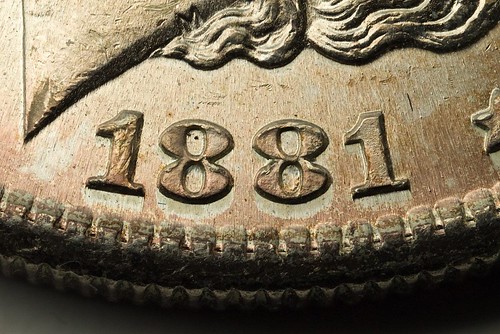
Pete Smith writes:
First let me describe what I believe is accepted by the experts. When a coin is struck, the metal flows outward. The sharp edge of lettering in the die acts as a dam that blocks metal flow. Surface metal fills the void in the lettering and subsurface metal is forced to the surface outside the lettering. What then causes differential toning is the topic of disagreement.
At first I thought that planchets were coated with a thin firm of oil, grease or wax that reacted with sulfur dioxide in the air to deposit silver sulfide on the coins. I never found a chemical explanation to make this work.
Silver bars, strips and blanks became tarnished as they were processed and annealed. At various stages they were cleaned with dilute sulfuric acid. In the right concentration this could dissolve copper. One theory is that copper was removed from the outer surface of the blank leaving almost pure silver. After striking, most of the surface was pure silver with some areas of 90% silver forced from the interior. The areas with higher concentration of silver toned faster than the areas with higher concentration of copper.
There are many other factors that explain why some Morgan dollars show rainbow toning, some show untoned areas outside letters and stars, and some have no toning or very light uniform toning.
I have seen the same general effect on some Conder tokens. If my explanation is correct for Morgan Dollars, it does nothing to explain similar effects on copper coins.
I am not an expert and have not heard a satisfactory explanation from an expert. I hope some other E-Sylum reader can come up with an explanation we will all accept.
Dick Johnson writes:
It is a form of surface displacement and is created at the instant of striking. It is not metal flowing into, then out of die cavities, as the two numismatists theorized. Surface metal flows toward the deepest die cavities. Since lettering, figures and stars near the border or rim are deep cavities, adjacent surface metal flows into these die cavities from metal near the rim. (The collar has nothing to do with it, as mentioned, this occurs on pieces struck with open face dies where no collar is present.)
The area with the unusual toning is in effect, flow marks, caused by the stress of the metal forced into nearby die cavities. All surface displacement occurs from the rim towards the center. Thus flow marks point to the center of the struck piece.
Tin and tin alloys have this very unusual property which displays the shadow effect. Tin does not work harden like other coinage metals. Instead it exhibits this condition in its flow marks. This shadow effect is not present immediately after the piece is struck. Freshly struck tin appears bright over the entire struck piece.
In time (say two years) tin surfaces will begin to darken from cold exposure -- this is a form of toning but is not called "toning" for tin and white metal. Instead it is called darkening on these metal surfaces. The dark areas on the surface piece which have darkened is a natural phenomenon. This dark area is in contrast to the flow marks caused by the surface displacement which remain bright on the same piece.
I have seen two-hundred-year-old medals struck in white metal which still have bright negative shadows! It is assumed this condition is now permanent and will exist forever!
The dark toning on white metal is a mild form of tin pest and is a result of the piece exposed to a cold temperature! Tin is unstable below 18 degrees centigrade (64 degrees Fahrenheit). Tin does not rust due to moist air (as does iron) but only by prolonged exposure to temperatures below 18 degrees C. The disease, also call tin plaque, forms a discoloration -- darkening on the struck surface -- then in time forms a gray powdery surface corrosion. Chemically the somewhat unstable metallic tin (beta-tin) changes to the stable powdery form (alpha-tin).
Why some silver coins display negative shadow and others do not, I don't know for sure, but I surmise there is some tin in the composition of the struck pieces that do exhibit negative shadow.
While shadows usually display dark areas, this phenomenon is just the opposite -- it displays bright areas. I guess it could have been called "reverse shadow" but this would have been confusing on coins and medals. Thus "negative" shadow.
I learned of this phenomenon from the old-timers at Medallic Art Company when I worked there decades ago. They were aware of this condition and tried to dissuade clients from using white metal or tin compositions for modern medals for this very reason.
I shared Dick’s comments with Pete and vice versa. Pete adds:
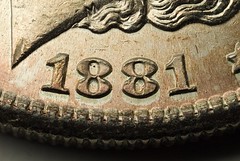 I hate to disagree with Dick Johnson on anything. I risk looking foolish and getting expelled from The E-Sylum.
I hate to disagree with Dick Johnson on anything. I risk looking foolish and getting expelled from The E-Sylum.In his explanation he said, “All surface displacement occurs from the rim towards the center.” While this may be true for high relief medals, I don’t think it is true for Morgan Dollars. At least in the area between lettering and the rim, surface displacement is outward. An unstruck planchet is smaller than the struck coin. Metal, both surface and interior, is forced outward into the reeded collar.
If we are both correct and surface displacement is different for medals and coins, then one explanation may not work for both types of items.
Later he says, “The dark areas on the surface piece which have darkened is a natural phenomenon. This is in contrast to the flow marks caused by the surface displacement which remain bright on the same piece.” This is a description but not an explanation. This also does not explain why other areas with surface displacement become toned.
I am happy to learn the term “negative shadow.” The explanation requires two parts. First, how is the metal different inside and outside these areas? Second, how does this difference influence toning? I still don’t know.
In turn, Dick replies:
Consider the metal in a blank as one homogenous mass. At the instant of striking a tremendous catastrophe occurs. The force of the two dies drive into this mass. The steel dies are obviously harder than the softer metal in the blank.
Metal in the blank must flow into the die cavities. That is the purpose of striking. Metal flows as one mass. On the surface this is towards the deepest cavity. This is usually the device, again usually in the center. Thus, adjacent metal moves toward this center in ever widening circles.
I don't believe metal moves toward the center in the middle and towards the border near the edge. It moves en mass. All surface displacement is toward the center. I stand by my previous statement that flow marks always point toward the center. (Or I could modify that to say all flow marks point to the high point on a struck piece.)
This is very evident in medal striking and dramatically exhibited on process sets -- samples after each stage of striking -- a sample is set aside after each blow. I wish we had samples like this in coining, however, this is impossible because it must be struck with one blow. Medal striking has the luxury of multiple striking., thus we can observe the process of metal movement in stages.
It would be interesting to observe flow marks on a struck piece, like, say, the 2005 or 2006 Westward Journey Jefferson nickels where the head of Jefferson -- the deepest cavity in the die -- is offset to the left. Question: Do flow marks point to the deepest cavity in the die, that is, the high point of Jefferson's head in these struck pieces?
If that is all true for the surface, then where does the metal come from to form the edge? Blanks must be smaller than the aperture of the collar (to be inserted). Again, metal moves en mass. It comes from adjacent metal in the blank, the metal next to the collar. It is forced up against the collar.
One further support for the theory of metal moving en mass is the phenomenon of congruent mass. This is where inexperienced coin designers place high relief areas back-to-back obverse to reverse. Not a problem in medal striking because multiple striking can bring up metal to fill such congruent die cavities.
For coining, however, this is a serious problem. Walter Breen mentioned in his Encyclopedia (p 260)this happened with the first striking in 1938 of the Jefferson nickel. (Perhaps this occurs with any new type coin.) Pressmen must increase the pressure of the press without squeezing out metal forming wire rims. They must achieve a balance of blank mass to proper pressure to achieve a fully struck item.
I have mentioned congruent mass in a previous E-Sylum article (vol 10, no 37, art 10, Sept 9, 2007) on the subject of High Relief. If E-Sylum readers would like more data on congruent mass, just ask. If you are a coin designer contact me by email: dick.johnson@snet.net for more tips on coin and medal design.
To read Dick's previous E-Sylum article, see: DICK JOHNSON ON THE DEFINITION OF HIGH RELIEF (www.coinbooks.org/esylum_v10n37a10.html)
QUERY: TERMITE FUMIGATION EFFECTS ON BOOKS
Ron Guth writes:WORLD COINS SOUGHT FOR PHOTOGRAPHY BOOK
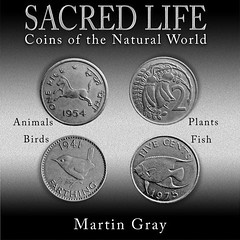 My name is Martin Gray and I am a National Geographic photographer preparing a new illustrated book on coins. The title of the book will be Sacred Life: Coins of the Natural World.
My name is Martin Gray and I am a National Geographic photographer preparing a new illustrated book on coins. The title of the book will be Sacred Life: Coins of the Natural World. The book will have black and white photographs of several hundred coins with the following living species shown on the coins:
- Animals
- Birds
- Fish
- Reptiles and Lizards
- Plants
I have so far photographed approximately 220 coins and those coins may be seen on the pages linked at the end of this letter (simply click each link to open the web page showing the coins). There are another 200 - 300 coins that I still need to photograph and I am hoping that various coin collectors and dealers will allow me to borrow those coins for a week so that I may photograph them. All of the borrowed coins will be returned to their owners promptly after they are photographed.
I am only interested in photographing coins that have been used during the past fifty years. It is important that the coins have been in circulation, as contrasted to mint condition, because I want readers of the book to feel as if the coins had been in their own pockets.
It is necessary that the details on the coins be clearly visible (the coins must not be so worn that the details are not clear). Coins with scratches are fine but coins with stains are not suitable. The coins may be of any denomination and I am not seeking coins that have any value beyond their face value. The book will not have photographs of paper currency - only coins will be shown.
For a list of coins still needed, see sacredsites.com/coins/lizards/ .
If you could lend any of these coins for the project, please contact me at your earliest convenience because the production schedule for the book requires that all the coins be photographed by the end of April at the latest. If you would like to speak with me about this matter, my phone number in Arizona is 928-274-5699. Thank you.
COINS ALREADY PHOTOGRAPHED
U.S. COIN BOOKS, CHINESE PRINTERS, AND CHINESE COIN FAKES
- 2001 Red Book hard cover - Printed in USA
- 2002 Red Book hard cover - USA (most pre-2002 titles I have are printed in USA)
- 2005 Red Book Leather - USA
- 2006 Red Book Leather - USA
- 2007 Red Book Leather - China
- 2007 Red Book 1947 Tribute - China
- 2008 Red Book Leather - USA
- 2009 Red Book Leather - China
- 2003 100 Greatest U.S. Coins, 1st edition - Italy (H.E. Harris)
- 2005 U.S. Coins, a Study by Type - Canada
- 2006 100 Greatest Currency Notes - Canada
- 2007 100 Greatest Medals and Tokens - China
- 2008 100 Greatest Ancient coins - China
- 2005 Expert's Guide to Collecting - Canada
- 2008 Official Guide book to Lincoln Cents - China
- 2008 Official Guide book to Peace Dollars - China
- 2008 Grading Coins by Photograph - USA
- 2008 Early Paper Money of America - China (Krause)
It appears that as of 2003 the print jobs went to the lowest bidder or lowest-bidding country. A cynic with a vivid imagination might conjure up a connection between the U.S. coin reference books being printed in China and the recent proliferation of well-executed counterfeit coins entering the U.S. market from China.
After all, the Red Book and books like this new colonial encyclopedia are written by America's top numismatic scholars, detailing all the nuanced minutia that went into the making of each and every U.S. coin series: composition, size, weight, varieties, which process produced which coins, known counterfeits, etc. - all the useful information the enterprising young Chinese businessman needs to start a coin factory.
I wonder if Liu Ciyun, the guy from the Coin World articles, has these books on his desk in his coin factory office?
I certainly can't blame Whitman or any other publisher for wanting to remain profitable and viable companies, and kudos to them for embracing the global economy. These are quality, well-printed books (though the paper is slightly low-end). I will still buy them whatever country they are printed in, but if printing the books in the USA meant they had to charge an extra $10 per title, I would still buy them.
I am a printer myself and have seen many trade articles alluding to the plight of the industry. One large printer/publisher based near where I live recently laid off 550 employees. I have to say that seeing the words 'printed in China' on my treasured new numismatic books was a bit disheartening.
THE BOOK BAZARRE
MORE ON THE LAW AND NUMISMATIC BOOK TRANSLATION
I expressed the view that "As far as I know such translations violate no copyright laws provided you're doing so for personal use." This view was attacked elsewhere online, with one voluble online poster saying this was "completely wrong" and offering the definitive pronouncement that all language translation of copyrighted works without the copyright holder's permission is illegal, even strictly for your own use, contending also that the copyright law isn't about money or fairness.
Another poster offer the equally definitive pronouncement that translation of copyrighted works for personal use is legal but that it would be illegal if you shared the cost with others who also bought the original book because this would be considered "distributing."
I'm not a lawyer but I have taken one graduate course in communication law, and I have some understanding of the folly of laypeople making these kinds of definitive legal pronouncements. I've also written in some detail about the law and the Internet, interviewing experts, as a part of what I do for a living. This online discussion prompted me to write again, elsewhere, about the law in the age of the Internet, and in doing so I interviewed five lawyers who specialize in copyright and other intellectual property issues. I thought I'd also share here what I heard.
None of the lawyers I talked to would offer an unambiguous opinion about the legalities of this kind of language translation project, and opinions differed. One lawyer said for "personal use, the odds are that this would be regarded as fair use and would not result in a copyright infringement claim." Another disagreed, saying that this is probably "an infringement of copyright, technically, but it may not rise to the level of having the copyright law enforced." A third pointed out that commercial issues are as or more important than creative ones. "The courts are very focused on whether you're taking bread off the table of the author," he said, but this wouldn't be the case in this situation.
But he also said that you'd be at risk if the author made a conscious decision not to have the work translated, though this also is likely not the case in this situation as it would more likely be with a book of poetry, for instance. A fourth said that because the right of translation belongs to the copyright holder, it's safest to get his or her permission to translate a book. The fifth lawyer pointed out that when you can't contact the copyright holder, there are provisions in the international copyright law for obtaining a license to translate a book and even publish it commercially if a certain number of years have passed since the book's publication, depending on the country. Naturally, he said you should contact a lawyer.
The bottom line is that it's unclear exactly what the legalities are in this case because, as far as anybody I talked to knows, such a case hasn't been addressed by the courts, and even if it has, that case wouldn't be binding, only advisory, unless it was addressed by the Supreme Court.
Last I emailed him, Tsvi Rogin said he was trying to contact the publisher to get explicit permission to translate. In the meantime, "As far as I know such translations violate no copyright laws provided you're doing so for personal use" still holds true.
HAPPY BIRTHDAY TO THE CHICAGO COIN CLUB
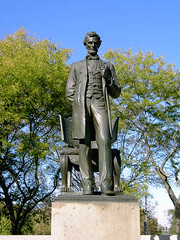 2009 is not only the 200th anniversary of the birth of Abraham Lincoln; it is also the 90th anniversary of the venerable Chicago Coin Club! To celebrate these twin milestones, the Club (ANA life membership 7) founded in 1919, is hosting an evening banquet April 25, 2009 at Giannotti Italian Steakhouse. The dinner event will be held in connection with the 34th annual Chicago International Coin Fair (CICF). Noted ancient coin dealer and author David Hendin will be the evening’s featured speaker.
2009 is not only the 200th anniversary of the birth of Abraham Lincoln; it is also the 90th anniversary of the venerable Chicago Coin Club! To celebrate these twin milestones, the Club (ANA life membership 7) founded in 1919, is hosting an evening banquet April 25, 2009 at Giannotti Italian Steakhouse. The dinner event will be held in connection with the 34th annual Chicago International Coin Fair (CICF). Noted ancient coin dealer and author David Hendin will be the evening’s featured speaker. The Club is issuing a special high relief rectangular medal to honor these two anniversary milestones. The medal depicts Augustus Saint-Gaudens’ bronze statue of the "Standing Lincoln" which is prominently displayed in Chicago's Lincoln Park. The statue is located on Chicago’s north side just east of the Chicago History Museum close to North Avenue beach and the shores of Lake Michigan.
Augustus Saint-Gaudens (1848-1907) was the renowned sculptor and engraver known world wide for his design of the Standing Liberty $20 gold piece (considered by some to be America’s most beautiful coin) at the request of then President Theodore Roosevelt. The custom produced high relief club medal will measure approximately 2.375” wide, 4” tall and .204” thick. Each medal will be individually serial numbered and come in a gift box. The medal will be available in bronze, silver or gold.
Pre-order price for the bronze medal is $25 plus postage and insurance. Those attending the CICF can save shipping charges by making arrangements in advance to pick up their medal(s) at the CICF show or the dinner banquet. Silver and Gold medals will be available by pre-paid advance order only with the exact prices to be determined shortly. The delay has been due to the current price volatility of the precious metals markets. A limited number of process sets will also be available.
For additional information regarding the Club’s 90th anniversary banquet or the high relief Abraham Lincoln medal, contact: www.ChicagoCoinClub.org/
For a 1986 history of the Chicago Coin Club, see: History of the Chicago Coin Club (www.chicagocoinclub.org/lib/club/ccc/PiN/ccc.html)
2009 PORTLAND NATIONAL MONEY SHOW MEDALS OFFERED
The Northwest Territorial Mint of Auburn, Washington produced the medals, which are of the highest quality. The sets are limited to a total of 200 of which 110 sets have already been sold. We have a good supply of silver and bronze but the orders from ANA are really hitting hard now from the pre-convention sales with the sets as the most popular item. The medal size is 39mm; the silver is .999, and the copper is pure.
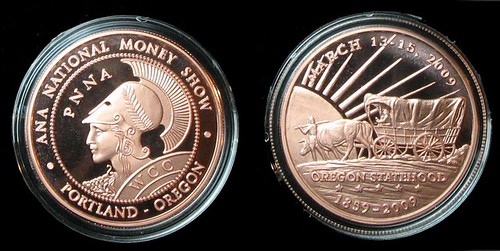
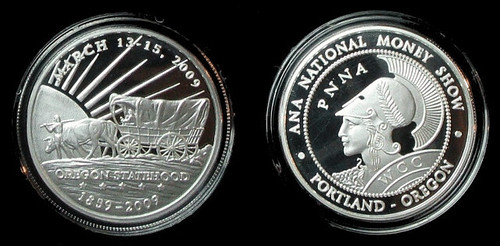
The logo for the WCC was initially designed by WCC club member John Tofte and NTM's rendering for medal striking was supervised by noted Oregon celator Greg Franck-Weiby of Silverton, Oregon. Greg is the celator of the Society for Creative Anachronism (SCA) in this area and has designed many medalettes for both the PNNA and WCC for their conventions as well as the medals for the 2004 ANA National Money Show in Portland. The Norwest Territorial Mint will also be manning a coin press at the show striking special hot struck medalettes for sale.
A special exhibit award based on the State of Oregon’s official celebration of the sesquicentennial was developed by the ANA to the exhibit that best exemplifies the Oregon Trail numismatically.
Credit Card orders can be made through the ANA website or the official application in The Numismatist. To order directly from the WCC/PNNA send a check or money order, no credit cards, to the Willamette Coin Club (www.pdxcoinclub.org) at:
WCC
C/o Larry Gaye
PO Box 1456
Beaverton, Or. 97075-1456
Checks should be made out to the Willamette Coin Club or WCC. You will not be disappointed; these are quite stunning reeded edge proof medals. I can be contacted by phone at 503 579 6416 or email light.man@verizon.net.
LAWRENCE MEYERS ON STANFORD INTERNATIONAL'S NUMISMATIC INVESTMENTS
Call me crazy, but why would any investor (much less a bank) want to inject millions of dollars of capital into a business that regularly lost money, with a low barrier to entry, and didn’t seem to have much of a future?
Then, in July of 2006, Superior announced a merger with DGSE Companies, Inc. (DGC). Here was another struggling entity, albeit one that had been turning a tiny profit from their business of selling wholesale and retail jewelry, gold bullion, and most recently had also entered the rare coin business. It had tried, and failed, to launch a payday loan business in New Mexico, and ran a pawn shop out of Dallas. DGSE’s stock had floundered in the $2 range for years. It had a credit line with Texas Capital Bank, but the sad truth was that they were consistently generating negative cash flow. While they had been making interest payments and their inventories were enough to cover the credit line, they never would have gotten out of debt. Texas Capital essentially owned the business.
So who facilitated the merger of these two flea-bitten mongrels? Stanford. They swooped in, offering an $18 million credit line subordinated to Texas Capital Bank, exchanging $6.5 million of it for about a 35% equity stake in the new company.
So, call me crazy, but why would any investor throw money at not one, but two struggling companies? Did they see some way of altering the merged entity’s strategies to make them more profitable? Not much has changed since the merger, so apparently that theory doesn’t work. Was it just really bad due diligence? Stanford didn’t become a billionaire by making such silly mistakes.
Perhaps the answer lies on Page 17 of the Sept. 30, 2006 10-Q for Superior. “On November 21, 2006, the company entered into an agreement with SIBL (Stanford) pursuant to which the balance outstanding under the Commercial LOC will be reduced by up to $2,408,481.81 through the transfer of rare coins to SIBL.”
Then there’s the 10Q for Q3 of the combined entity, in which “”During the first nine months of 2008, approximately $2,800,000 of our revenue was for bullions sales to Stanford Coin and Bullion, a wholly-owned subsidiary of Stanford International Bank Ltd., our second largest shareholder.”
Hmmm. $2.4 million of rare coins and $2.8 million in gold bullion transferred into Stanford’s possession? And all these media reports of money laundering?
I would caution that these revelations don’t prove anything. It is merely circumstantial. But when there’s smoke, there is often fire.
To read the complete article, see: Stanford International’s Pink Sheet Investments (http://www.bloggernews.net/119851)
MORE ON THE DEBATE FOR AND AGAINST NUMISMATIC MUSEUMS
Continuing the discussion on the merits of numismatic museums, Douglas Mudd writes:The staff of the National Numismatic Collection and many collectors who were aware of the situation opposed the takedown (as did scholars concerned about flag etiquette), but to no avail - the then-management of the museum was not interested in numismatics. There are over 6,000 gold items in the Lilly collection including approximately 50 of the ingots Alan mentions. The vast majority of the collection is of unquestioned authenticity. Of the four ingots that have been scientifically examined by knowledgeable and unbiased experts (Bob Evans and Fred Holabird), two were found to be fakes. This is the area where many previously questioned pieces have been vindicated by recent underwater archaeology.
On the subject of museums containing fakes - there is no better place for them. They can then form a benchmark with which to compare and check other pieces for authenticity instead of being passed from unsuspecting collector to another or, worse, from collectors or dealers who do know that they are fakes. At the least the pieces are out of the market.
Of course, Alan's initial point is unfortunately quite valid, especially in the U.S. Without proper staffing and support, public museums cannot do what they have a responsibility to do - make their collections available to the public through exhibitions and publications (books, the web, etc.) or to trusted researchers for study.
It is a terrible problem, and one which will not be solved easily. As a museum professional I wish I could do more to make it happen - I have done my best - as have my colleagues - at the Smithsonian as well as at the ANA.
Unfortunately, it is tough when staffing continues to drop - at the Smithsonian's National Numismatic Collection from eleven positions in 1990 to two in 2004 when I left. The British Museum and British numismatic collections in general seem to have had the best record of maintaining numismatic collections and providing for access and publication - most notably the various British Museum catalogs, which are essential within their research areas.
FEATURED WEB PAGE: COUNTERFEITS & FORGERIES
This week's Featured Web Page is an article by Ian Hartshorn on Counterfeits & Forgeries. It was published in the January 2007 issue of Tasmanian Numismatist. Many thanks to Jim Spilman who published the URL on the blog of Early American Numismatics (CNLF). The page includes several articles, including one on Blacksmith coppers.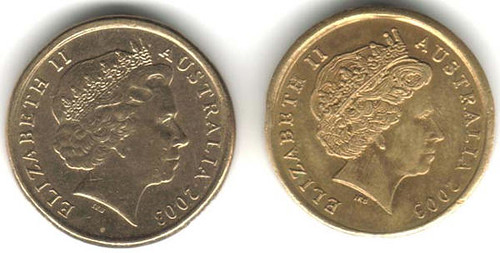
www.vision.net.au/~pwood/jan07.htm
